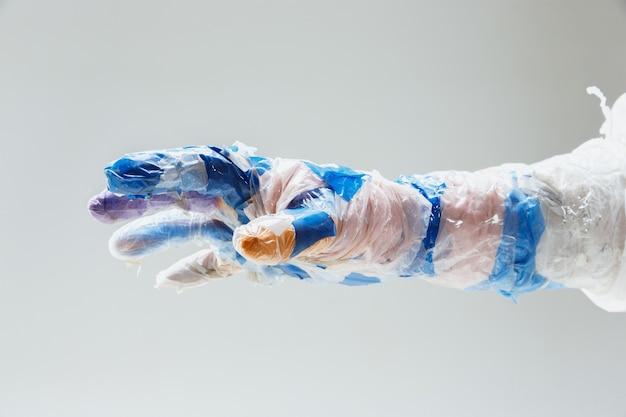Plaster of Paris is a versatile material commonly used in various construction and art projects. It is known for its easy-to-use nature and ability to create detailed molds and casts. However, despite its widespread usage, there are potential dangers associated with plaster of Paris that are important to be aware of.
In this blog post, we will explore the potential health hazards of using plaster of Paris, the risks of ingesting or exposing oneself to it, and the precautions that should be taken when working with this material. We will also discuss alternative options to consider and delve into the environmental impact of plaster of Paris.
Overall, it is crucial to understand the potential dangers of plaster of Paris to ensure that its usage is done in a safe and informed manner. So, let’s dive in and examine why plaster of Paris can pose risks to our health and wellbeing.
Why Is Plaster Of Paris Dangerous
Plaster of Paris may seem harmless, with its smooth texture and delightful namesake that conjures up images of art projects and beautiful sculptures. But don’t be fooled by its innocent facade! This seemingly innocuous substance can actually pose numerous dangers if not handled with caution. So, let’s dive into the potential hazards associated with plaster of Paris and learn why it should be treated with respect.
Inhalation Hazards: Choking on Creativity
When working with plaster of Paris, one of the main concerns is the risk of inhaling its fine particles. Although it may seem tempting to catch a whiff of that freshly mixed gypsum, resist the urge! Inhalation of plaster of Paris dust can cause irritation to the respiratory system, leading to coughing, shortness of breath, and in severe cases, even respiratory distress. So, unless you’re aiming for a choking sensation that isn’t artistic, it’s best to keep a safe distance from the cloud of powder.
Skin Contact: A Sticky Situation
Plaster of Paris, when mixed with water, transforms into a gooey substance that hardens into a solid form. While this might be desirable for creating sturdy sculptures, it’s not so great for your skin. Prolonged exposure to wet plaster can cause irritation, dryness, and even chemical burns. Now, I’m no dermatologist, but “plaster-chic” is most definitely not the latest skincare trend. So, unless you’re trying to achieve a reptilian look, make sure to keep your hands and body well-protected when handling this potentially sticky situation.
Fire Hazard: Don’t Set Your Creativity Ablaze
Forget about playing with fire – when it comes to working with plaster of Paris, you might unknowingly be doing just that! While the chemical reaction that turns plaster into its solid state is fascinating, it’s also highly exothermic. In plain English, it means that as the plaster hardens, it gives off heat. And guess what loves heat? Yep, you got it, fire! If your creative endeavors involve heating plaster of Paris or using it near heat sources, exercise extreme caution. The last thing you want is to unintentionally set ablaze not only your masterpiece but also your aspirations.
Eye Contact: Not the Staring Contest You Want
Ever engaged in a staring contest and blinked at the worst possible moment? Well, imagine that, but with plaster of Paris. Unprotected eyes are a big no-no when working with this material. In case you were curious, plaster particles are not the best companions for your precious peepers. They have an irritating tendency to cause eye redness, itching, and, in severe cases, corneal abrasions. So, unless you’ve always dreamed of sporting a pirate eyepatch or looking like a disgruntled insomniac, I suggest investing in a pair of protective goggles. Your eyes will thank you!
Environmental Impact: When Creativity Clashes with Responsibility
Let’s face it – the world has enough challenges already without adding plaster of Paris to the mix. Unfortunately, this compound isn’t the most environmentally friendly. Plaster of Paris, when improperly disposed of, can find its way into waterways, negatively impacting aquatic ecosystems. The excess gypsum can upset the delicate balance of underwater life, and nobody wants to be responsible for unintentionally throwing an underwater party for uninvited creatures. So, make sure to dispose of plaster waste responsibly and help keep Mother Nature’s dance floor free of any unwanted surprises.
Now that you’re armed with knowledge about the potential dangers lurking behind that innocent bag of plaster of Paris, you can approach your artistic exploits with caution and care. Remember, the goal is to create lasting masterpieces, not lasting regrets. So, protect yourself, protect your surroundings, and let your creativity flow, all while keeping danger at bay. Stay safe, my fellow artists!
FAQ: Why Is Plaster of Paris Dangerous
Plaster of Paris is a versatile material commonly used in construction, arts and crafts, and other applications. While it has its uses, it’s important to be aware of potential dangers associated with its handling and exposure. In this FAQ-style guide, we will address common concerns and questions regarding the safety and potential risks of using plaster of Paris.
Does Plaster of Paris Cause Cancer
No, plaster of Paris itself is not known to cause cancer. However, it’s important to be cautious when working with it as the dust particles produced during sanding or mixing can irritate the respiratory system. It’s advisable to wear protective gear like masks and goggles to minimize potential health risks.
Is Drywall Dangerous to Eat
While drywall contains gypsum, which is a component of plaster of Paris, it is not safe to consume. Drywall may contain other substances such as adhesives or paint that are toxic when ingested. So, it’s best to steer clear of eating it!
Is Plaster of Paris Harmful for Health
Plaster of Paris can be harmful to health if proper precautions are not taken. When inhaling the dust particles or exposing it to open wounds, it can cause irritation and allergic reactions. It’s important to follow safety guidelines, use appropriate protection, and employ proper ventilation when working with plaster of Paris.
Can Plaster Make You Blind
No, plaster of Paris cannot make you blind. However, if it gets into your eyes, it can cause irritation and discomfort. If this happens, make sure to rinse your eyes with clean water immediately and seek medical attention if needed.
What is Stronger Than Plaster of Paris
Several materials are stronger than plaster of Paris. For construction purposes, materials such as concrete, cement, or even fiberglass can offer greater strength and durability.
What is an Alternative to Plaster of Paris
If you’re looking for an alternative to plaster of Paris, there are a few options available. Some alternatives include epoxy clay, air-dry clay, or even papier-mâché. Each of these alternatives offers unique benefits and characteristics for various applications.
What Will Happen if We Eat Plaster of Paris
Ingesting plaster of Paris can be harmful to your health. When consumed, it can lead to digestive issues, including blockages in the intestines. It’s important to keep plaster of Paris out of reach of children and ensure it is not mistaken for food or consumed accidentally.
Is Plaster of Paris Safe for Skin
While plaster of Paris is generally safe for skin contact, prolonged or repeated exposure can cause irritation and dryness. It’s advisable to avoid direct contact with the skin, especially for individuals with sensitive skin or existing skin conditions. Using gloves or a barrier cream can provide added protection when handling plaster of Paris.
Is Sanding Plaster Dangerous
Sanding plaster can create dust particles that, if inhaled, can irritate the respiratory system. It’s essential to take appropriate safety measures when sanding, such as wearing a proper mask, using adequate ventilation, and minimizing the spread of dust by wetting the surface.
Will You Die if You Eat Putty
Eating putty, including plaster of Paris putty, can be hazardous to your health. Putty often contains toxic substances and chemicals that can lead to serious health complications if ingested. It’s crucial to keep putty away from children and ensure it is not mistaken for food.
Is Plaster of Paris Eco-Friendly
Plaster of Paris is not considered eco-friendly. It consists of gypsum, which is a non-renewable resource. Additionally, the manufacturing process of plaster of Paris involves high energy consumption. Considering more sustainable alternatives like recycled materials or bio-based alternatives can be a more environmentally friendly choice.
Is Plaster of Paris Waterproof
Plaster of Paris is not inherently waterproof. It is a porous material that can absorb moisture and eventually break down when exposed to water. If you require a waterproof solution, it’s advisable to explore other materials specifically designed for that purpose.
Does Plaster of Paris Break Easily
In comparison to stronger materials like concrete or fiberglass, plaster of Paris is relatively brittle and can break easily under pressure or strain. It’s important to handle plaster of Paris objects with care to avoid unintentional breakage.
Is Plaster Poisonous to Dogs
Plaster can be harmful to dogs if ingested in large quantities. It can cause digestive issues and blockages. If your dog has consumed plaster, it’s important to consult with a veterinarian for proper guidance and care.
Is Plaster of Paris Good for Face
Plaster of Paris should not be used directly on the face due to its potential for skin irritation and dryness. However, there are specially formulated facial masks and molds available that are made from different materials and are designed for safe use on the face.
Does Plaster of Paris Shrink When it Dries
Yes, plaster of Paris does experience some shrinkage as it dries. This shrinkage can range from 0.5% to 2%, depending on the mix and environmental conditions. It’s essential to take this into consideration when using plaster of Paris for precise molds or casts.
What are the Disadvantages of Plaster of Paris
While plaster of Paris has its uses, it also comes with a few disadvantages. These include its relatively low strength compared to other materials, its limited resistance to moisture, and the potential for irritation when handling or inhaling the dust particles. It’s crucial to consider these factors when selecting the right material for your project.
How Do You Strengthen Plaster of Paris
To strengthen plaster of Paris, you can consider adding various reinforcing materials such as fiberglass, paper fibers, or even glue. These additives can enhance the overall strength and durability of the plaster of Paris mixture when properly incorporated.
Can I Mix Plaster of Paris with Cement
Yes, mixing plaster of Paris with cement is possible. This combination can provide added strength and durability, making it suitable for certain applications requiring more resilience than standard plaster of Paris can offer. Be sure to follow recommended mixing ratios and guidelines for the desired results.
Why is Plaster of Paris Toxic
Plaster of Paris is not inherently toxic, but its fine dust particles can irritate the respiratory system and cause discomfort if inhaled. It’s important to handle plaster of Paris with caution, follow proper safety measures, and avoid prolonged exposure to minimize potential health risks.
How Toxic is Plaster
Plaster, including plaster of Paris, is not considered highly toxic. However, the dust particles produced during sanding or mixing can irritate the respiratory system. It’s crucial to use protective gear and ensure proper ventilation when working with plaster to minimize any potential health effects.
In conclusion, while plaster of Paris offers various benefits and uses, it’s important to be mindful of the potential risks and take adequate safety precautions when working with it. By following the proper guidelines and understanding the hazards associated with plaster of Paris, you can use it safely and confidently in your projects.

